2013 MERCEDES-BENZ G-CLASS SUV weight
[x] Cancel search: weightPage 334 of 364

Step 3
Example 1 Example 2 Example 3
Permissible load
(maximum gross
vehicle weight
rating from the
Tire
and Loading
Information
placard minus the
gross weight of all
occupants) 1500 lbs (680 kg)
00FC750 lbs (340 kg) =
750 lbs (340 kg) 1500 lbs (680 kg)
00FC540 lbs (245 kg) =
960 lbs (435 kg) 1500 lbs (680 kg)
00FC150 lbs (68 kg) =
1350 lbs (612 kg)
Vehicle identification plate
Even if you have calculated the total load
carefully, you should still make sure that the
gross vehicle weight rating
and the gross axle
weight rating are not exceeded. Details can
be found on the vehicle identification plate on
the B-pillar on the driver's side of the vehicle
(Y page 328).
Permissible gross vehicle weight: the
gross weight of the vehicle, all passengers,
load and trailer load/noseweight (if
applicable) must not exceed the permissible
gross vehicle weight.
Gross axle weight rating: the maximum
permissible weight that can be carried by one
axle (front or rear axle).
To ensure that your vehicle does not exceed
the maximum permissible values (gross
vehicle weight and maximum gross axle
weight rating), have your loaded vehicle
(including driver, occupants, cargo, and full
trailer load if applicable) weighed on a
suitable vehicle weighbridge. Trailer load/noseweight
The trailer load/noseweight affects
the gross
weight of the vehicle. If a trailer is attached,
the trailer load/noseweight is included in the
load along with occupants and luggage. The
trailer load/noseweight is usually approximately 10% of the
gross
weight of the
trailer and its load.
Only use a trailer tow hitch that has been
approved for your vehicle by Mercedes-Benz.
Comply with the manufacturer's operating
instructions for operation, care and
maintenance. Uniform Tire Quality Grading
Standards
Overview of Tire Quality Grading
Standards
Uniform Tire Quality Grading Standards are
U.S. government specifications. Their
purpose is to provide drivers with uniform
reliable information on tire
performance data.
Tire manufacturers have to grade tires using
three performance factors: 0043 tread wear
grade, 0044 traction grade and 0087 temperature
grade. These regulations do not apply to 332
Uniform Tire Quality Grading Standards
Wheels and tires
Page 339 of 364
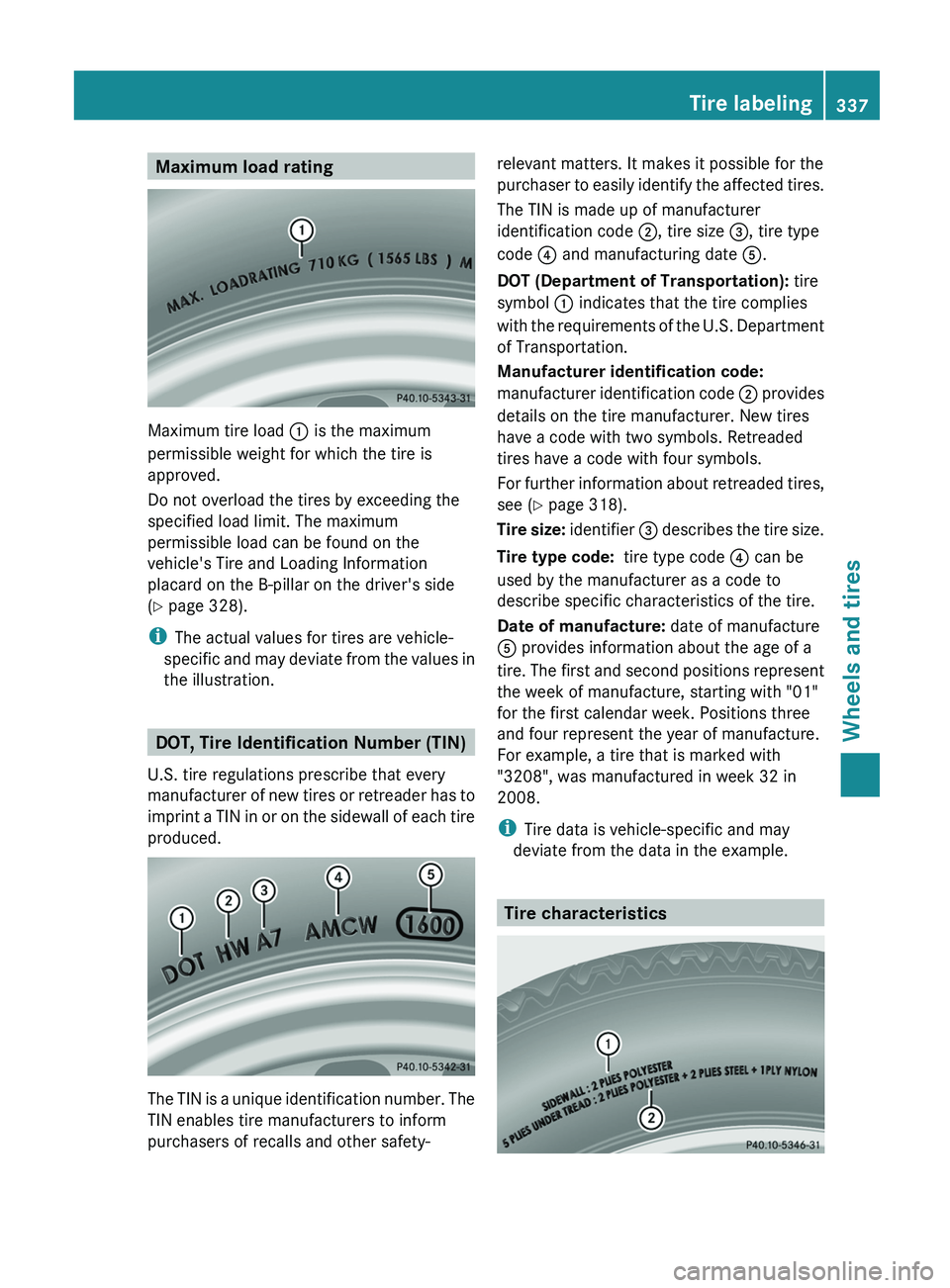
Maximum load rating
Maximum tire load
0043 is the maximum
permissible weight for which the tire is
approved.
Do not overload the tires by exceeding the
specified load limit. The maximum
permissible load can be found on the
vehicle's Tire and Loading Information
placard on the B-pillar on the driver's side
(Y page 328).
i The actual values for tires are vehicle-
specific
and may deviate from the values in
the illustration. DOT, Tire Identification Number (TIN)
U.S. tire regulations prescribe that every
manufacturer of new tires
or retreader has to
imprint a TIN in or on the sidewall of each tire
produced. The TIN is a unique identification number. The
TIN enables tire manufacturers to inform
purchasers of recalls and other safety- relevant matters. It makes it possible for the
purchaser
to easily
identify
the affected tires.
The TIN is made up of manufacturer
identification code 0044, tire size 0087, tire type
code 0085 and manufacturing date 0083.
DOT (Department of Transportation): tire
symbol 0043 indicates that the tire complies
with the requirements of the U.S. Department
of Transportation.
Manufacturer identification code:
manufacturer identification code 0044 provides
details on the tire manufacturer. New tires
have a code with two symbols. Retreaded
tires have a code with four symbols.
For further information about retreaded tires,
see ( Y page 318).
Tire size: identifier 0087 describes the tire size.
Tire type code: tire type code 0085 can be
used by the manufacturer as a code to
describe specific characteristics of the tire.
Date of manufacture: date of manufacture
0083 provides information about the age of a
tire. The first and second positions represent
the week of manufacture, starting with "01"
for the first calendar week. Positions three
and four represent the year of manufacture.
For example, a tire that is marked with
"3208", was manufactured in week 32 in
2008.
i Tire data is vehicle-specific and may
deviate from the data in the example. Tire characteristics Tire labeling
337
Wheels and tires Z
Page 340 of 364
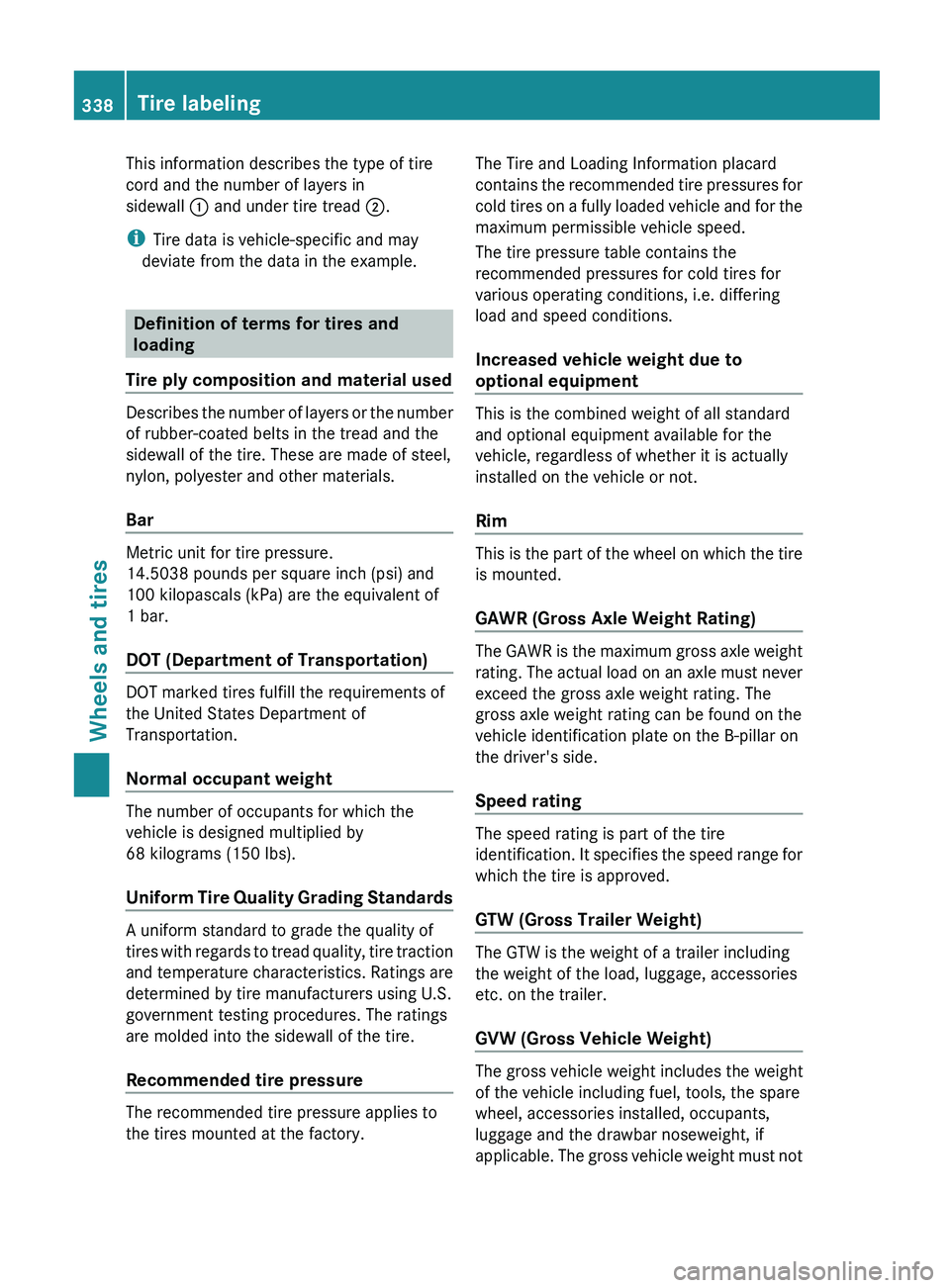
This information describes the type of tire
cord and the number of layers in
sidewall
0043 and under tire tread 0044.
i Tire data is vehicle-specific and may
deviate from the data in the example. Definition of terms for tires and
loading
Tire ply composition and material used Describes the number of layers or the number
of rubber-coated belts in the tread and the
sidewall of the tire. These are made of steel,
nylon, polyester and other materials.
Bar
Metric unit for tire pressure.
14.5038 pounds per square inch (psi) and
100 kilopascals (kPa) are the equivalent of
1 bar.
DOT (Department of Transportation) DOT marked tires fulfill the requirements of
the United States Department of
Transportation.
Normal occupant weight
The number of occupants for which the
vehicle is designed multiplied by
68 kilograms (150 lbs).
Uniform
Tire Quality
Grading
StandardsA uniform standard to grade the quality of
tires with regards
to
tread quality, tire traction
and temperature characteristics. Ratings are
determined by tire manufacturers using U.S.
government testing procedures. The ratings
are molded into the sidewall of the tire.
Recommended tire pressure The recommended tire pressure applies to
the tires mounted at the factory. The Tire and Loading Information placard
contains the recommended
tire
pressures for
cold tires on a fully loaded vehicle and for the
maximum permissible vehicle speed.
The tire pressure table contains the
recommended pressures for cold tires for
various operating conditions, i.e. differing
load and speed conditions.
Increased vehicle weight due to
optional equipment This is the combined weight of all standard
and optional equipment available for the
vehicle, regardless of whether it is actually
installed on the vehicle or not.
Rim
This is the part of the wheel on which the tire
is mounted.
GAWR (Gross Axle Weight Rating)
The GAWR is the maximum gross axle weight
rating. The actual
load
on an axle must never
exceed the gross axle weight rating. The
gross axle weight rating can be found on the
vehicle identification plate on the B-pillar on
the driver's side.
Speed rating The speed rating is part of the tire
identification. It specifies
the
speed range for
which the tire is approved.
GTW (Gross Trailer Weight) The GTW is the weight of a trailer including
the weight of the load, luggage, accessories
etc. on the trailer.
GVW (Gross Vehicle Weight)
The gross vehicle weight includes the weight
of the vehicle including fuel, tools, the spare
wheel, accessories installed, occupants,
luggage and the drawbar noseweight, if
applicable. The gross
vehicle
weight must not338
Tire labeling
Wheels and tires
Page 341 of 364
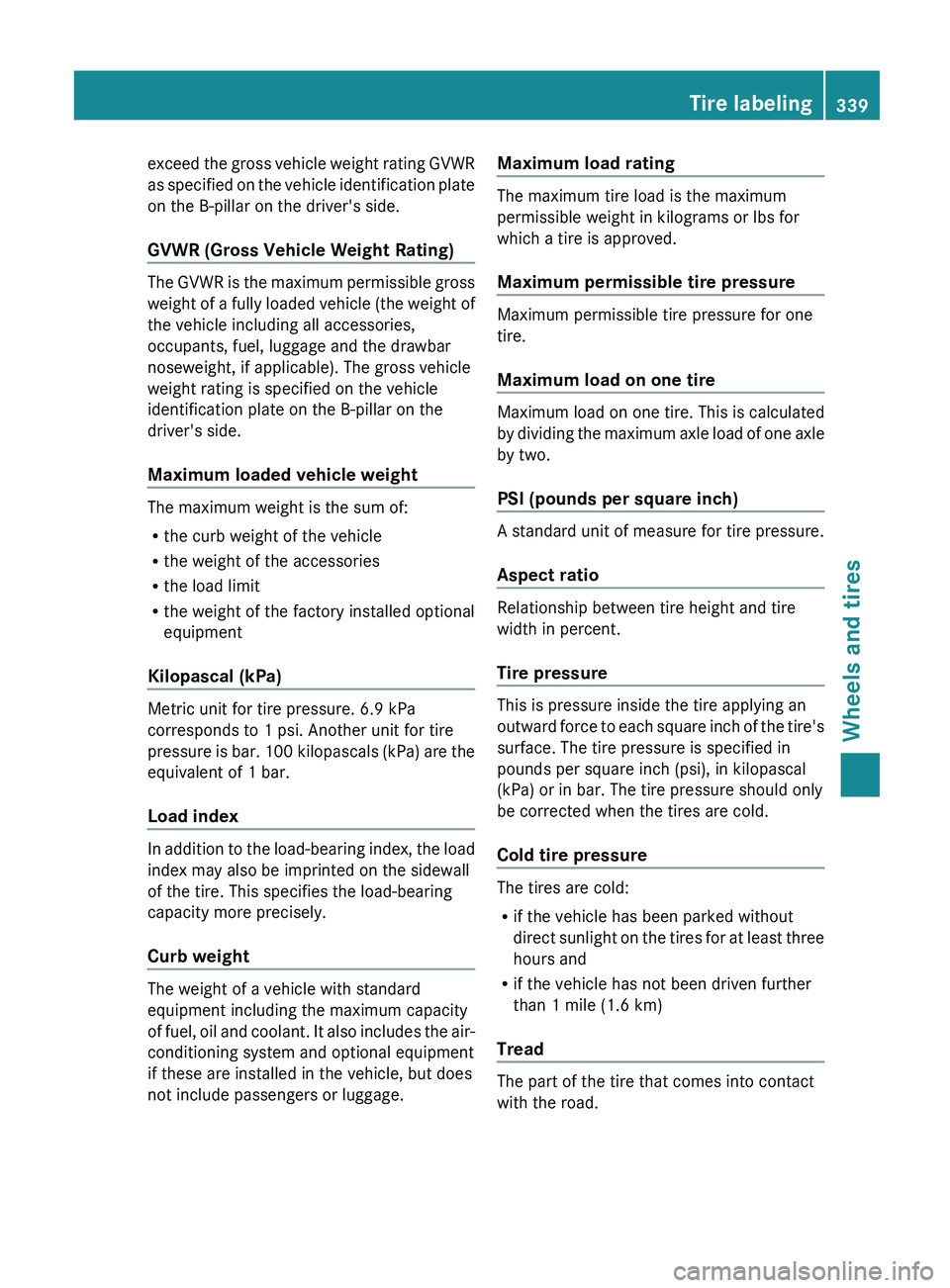
exceed the gross vehicle weight rating GVWR
as specified on
the
vehicle identification plate
on the B-pillar on the driver's side.
GVWR (Gross Vehicle Weight Rating) The GVWR is the maximum permissible gross
weight of a
fully
loaded vehicle (the weight of
the vehicle including all accessories,
occupants, fuel, luggage and the drawbar
noseweight, if applicable). The gross vehicle
weight rating is specified on the vehicle
identification plate on the B-pillar on the
driver's side.
Maximum loaded vehicle weight The maximum weight is the sum of:
R
the curb weight of the vehicle
R the weight of the accessories
R the load limit
R the weight of the factory installed optional
equipment
Kilopascal (kPa) Metric unit for tire pressure. 6.9 kPa
corresponds to 1 psi. Another unit for tire
pressure is bar.
100
kilopascals (kPa) are the
equivalent of 1 bar.
Load index In addition to the load-bearing index, the load
index may also be imprinted on the sidewall
of the tire. This specifies the load-bearing
capacity more precisely.
Curb weight
The weight of a vehicle with standard
equipment including the maximum capacity
of
fuel, oil
and
coolant. It also includes the air-
conditioning system and optional equipment
if these are installed in the vehicle, but does
not include passengers or luggage. Maximum load rating The maximum tire load is the maximum
permissible weight in kilograms or lbs for
which a tire is approved.
Maximum permissible tire pressure
Maximum permissible tire pressure for one
tire.
Maximum load on one tire
Maximum load on one tire. This is calculated
by dividing the
maximum
axle load of one axle
by two.
PSI (pounds per square inch) A standard unit of measure for tire pressure.
Aspect ratio
Relationship between tire height and tire
width in percent.
Tire pressure
This is pressure inside the tire applying an
outward force to
each
square inch of the tire's
surface. The tire pressure is specified in
pounds per square inch (psi), in kilopascal
(kPa) or in bar. The tire pressure should only
be corrected when the tires are cold.
Cold tire pressure The tires are cold:
R
if the vehicle has been parked without
direct sunlight on the
tires for at least three
hours and
R if the vehicle has not been driven further
than 1 mile (1.6 km)
Tread The part of the tire that comes into contact
with the road. Tire labeling
339
Wheels and tires Z
Page 342 of 364

Bead
The tire bead ensures that the tire sits
securely on the
wheel.
There are several steel
wires in the bead to prevent the tire from
coming loose from the wheel rim.
Sidewall The part of the tire between the tread and the
bead.
Weight of optional extras
The combined weight of those optional extras
that weigh more than the replaced standard
parts and more than 2.3 kg (5 lbs). These
optional extras, such as high-performance
brakes, level control, a roof rack or a high-
performance battery, are not included in the
curb weight and the weight of the
accessories.
TIN (Tire Identification Number) This is a unique identifier which can be used
by a tire manufacturer to identify tires, for
example for a
product
recall, and thus identify
the purchasers. The TIN is made up of the
manufacturer's identity code, tire size, tire
type code and the manufacturing date.
Load bearing index The load bearing index (also load index) is a
code
that
contains the
maximum load bearing
capacity of a tire.
Traction Traction is the result of friction between the
tires and the road surface.
TWR (Tongue Weight Rating)
The TWR specifies the maximum permissible
weight that the
ball
coupling of the trailer tow
hitch can support. Treadwear indicators Narrow bars (tread wear bars) that are
distributed over the
tire
tread. If the tire tread
is level with the bars, the wear limit of 00CD in
(1.6 mm) has been reached.
Occupant distribution The distribution of occupants in a vehicle at
their designated seating positions.
Total load limit
Nominal load and luggage load plus 150 lbs
(68 kg) multiplied by the number of seats in
the vehicle.
Changing a wheel
Flat tire
The "Breakdown assistance" section
(Y page 304)
contains
information and notes
on how to deal with a flat tire. Interchanging the wheels
G
WARNING
Rotate front and rear wheels only if the tires
are of the same dimension.
If your vehicle is equipped with mixed-size
tires (different tire dimensions
front vs. rear),
tire rotation is not possible. G
WARNING
Have the tightening torque checked after
changing a wheel. The wheels could come
loose if they are not tightened to a torque of
96 lb-ft (130 Nm).
Only use genuine
Mercedes-Benz wheel bolts
specified for your vehicle's rims.
! On vehicles equipped with a tire pressure
monitor, electronic components are
located in the wheel. 340
Changing a wheel
Wheels and tires
Page 359 of 364
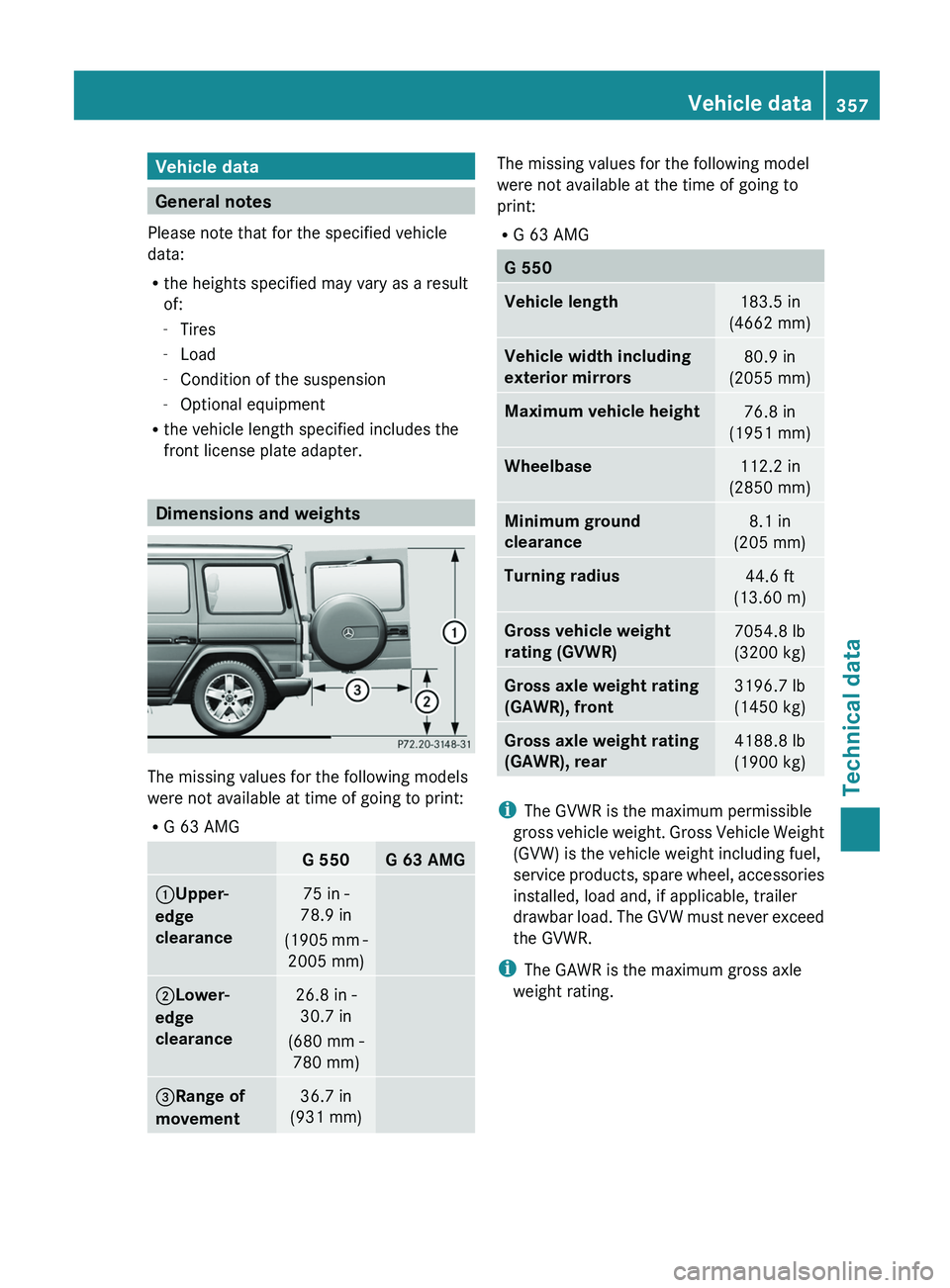
Vehicle data
General notes
Please note that for the specified vehicle
data:
R the heights specified may vary as a result
of:
-Tires
- Load
- Condition of the suspension
- Optional equipment
R the vehicle length specified includes the
front license plate adapter. Dimensions and weights
The missing values for the following models
were not available at time of going to print:
R
G 63 AMG G 550 G 63 AMG
0043Upper-
edge
clearance 75 in -
78.9 in
(1905 mm -
2005 mm
) 0044Lower-
edge
clearance 26.8 in -
30.7 in
(680 mm - 780 mm) 0087Range of
movement 36.7 in
(931 mm) The missing values for the following model
were not available at the time of going to
print:
R
G 63 AMG G 550
Vehicle length
183.5 in
(4662 mm) Vehicle width including
exterior mirrors
80.9 in
(2055 mm) Maximum vehicle height
76.8 in
(1951 mm) Wheelbase
112.2 in
(2850 mm) Minimum ground
clearance
8.1 in
(205 mm) Turning radius
44.6 ft
(13.60 m) Gross vehicle weight
rating (GVWR)
7054.8 lb
(3200 kg) Gross axle weight rating
(GAWR), front
3196.7 lb
(1450 kg) Gross axle weight rating
(GAWR), rear
4188.8 lb
(1900 kg) i
The GVWR is the maximum permissible
gross vehicle weight. Gross
Vehicle Weight
(GVW) is the vehicle weight including fuel,
service products, spare wheel, accessories
installed, load and, if applicable, trailer
drawbar load. The GVW must never exceed
the GVWR.
i The GAWR is the maximum gross axle
weight rating. Vehicle data
357Technical data Z
Page 360 of 364
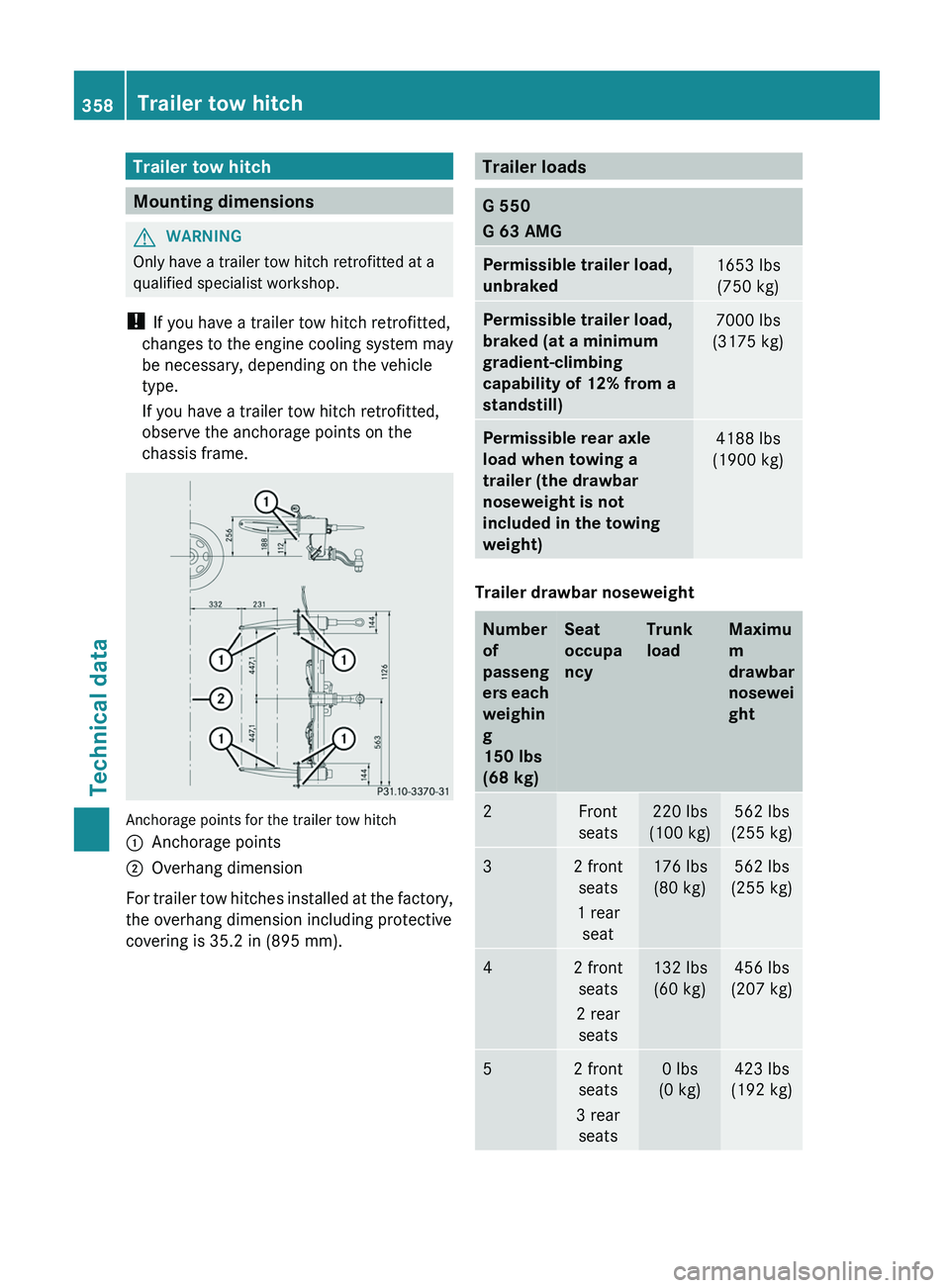
Trailer tow hitch
Mounting dimensions
G
WARNING
Only have a trailer tow hitch retrofitted at a
qualified specialist workshop.
! If you have a trailer tow hitch retrofitted,
changes to the engine
cooling system may
be necessary, depending on the vehicle
type.
If you have a trailer tow hitch retrofitted,
observe the anchorage points on the
chassis frame. Anchorage points for the trailer tow hitch
0043
Anchorage points
0044 Overhang dimension
For trailer tow hitches installed at the factory,
the overhang dimension including protective
covering is 35.2 in (895 mm). Trailer loads
G 550
G 63 AMG
Permissible trailer load,
unbraked
1653 lbs
(750 kg) Permissible trailer load,
braked (at a minimum
gradient-climbing
capability of 12% from a
standstill)
7000 lbs
(3175 kg) Permissible rear axle
load when towing a
trailer (the drawbar
noseweight is not
included in the towing
weight)
4188 lbs
(1900 kg) Trailer drawbar noseweight
Number
of
passeng
ers each
weighin
g
150 lbs
(68 kg) Seat
occupa
ncy Trunk
load Maximu
m
drawbar
nosewei
ght
2 Front
seats 220 lbs
(100 kg) 562 lbs
(255 kg) 3 2 front
seats
1 rear seat 176 lbs
(80 kg) 562 lbs
(255 kg) 4 2 front
seats
2 rear seats 132 lbs
(60 kg) 456 lbs
(207 kg) 5 2 front
seats
3 rear seats 0 lbs
(0 kg) 423 lbs
(192 kg) 358
Trailer tow hitch
Technical data